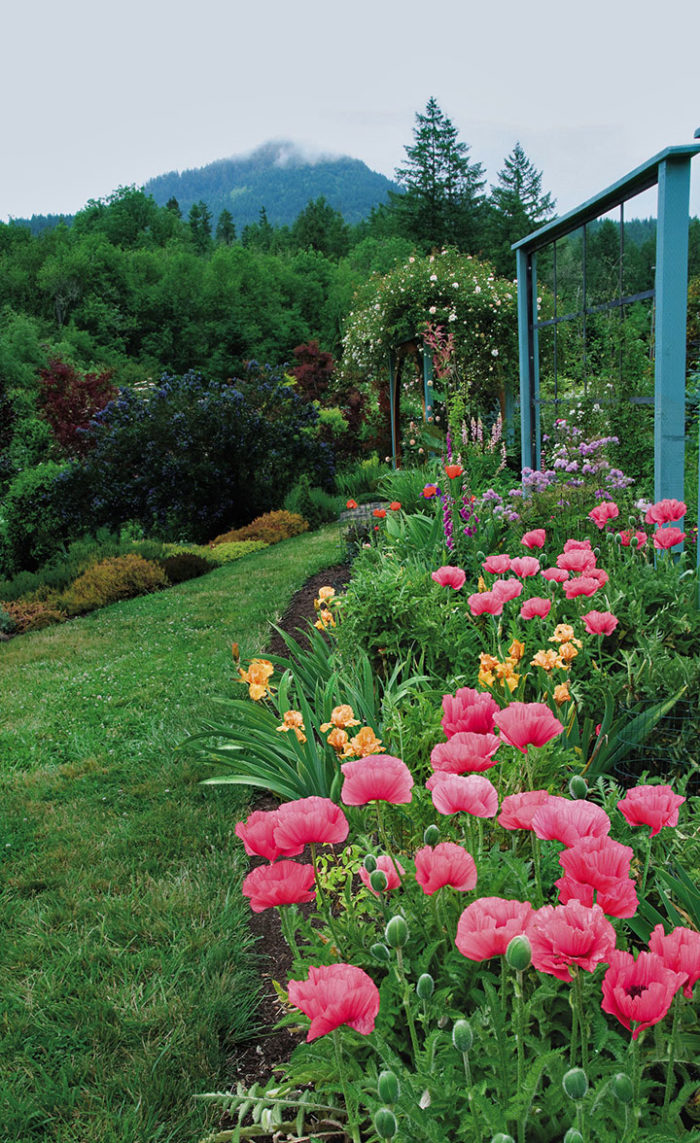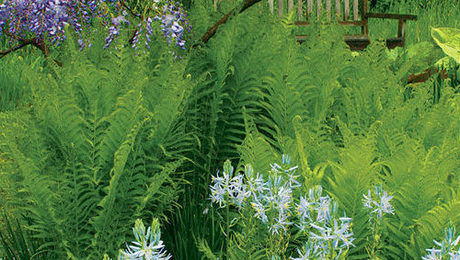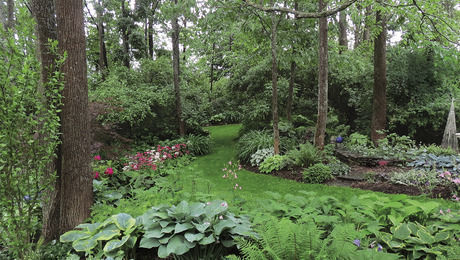
Coloring outside the lines takes creativity and a good bit of courage. Bryan and Cassandra Barrett have both. As a contractor and garden designer, respectively, this husband-and-wife duo makes a living conceptualizing, installing, and maintaining gardens under the name Barrett Landscape and Design. There are no formulas for the gardens they create. At their home in Dexter, Oregon, you won’t find symmetrical groupings, tidy rows, or manicured shrubs. Their garden has a fluid, natural look. And yet, with all its layers, ornaments, and myriad plants, there is nothing messy about it. Like any well-designed informal garden, it maintains a sense of order without looking rigid. But how, exactly, is that accomplished? How do the Barretts unify so many seemingly random plants to create something so beautiful? Or rather, how do they color outside the lines and do it so well? Their approach is simpler than it might look. See two secrets to great garden design below.

Step 1: Pay attention to every layer of your garden
The Barretts’ garden is exceptional for many reasons: dramatic year-round color, meandering gravel paths, and contrasting textures, for example. But less obvious is the way each level of the landscape steps down gradually—from the tallest Thompson blue spruce (Picea pungens ‘Thompson’, USDA Hardiness Zones 2–8), to the Barretts’ clapboard farmhouse, to the epimedium (Epimedium spp. and cvs., Zones 5–9) cascading onto walkways. Each element is integrated. This effect is, of course, intentional. Smooth transitions and dense beds are what happens when gardeners know how to layer—and Cassandra has layering down to an art form. For her, every garden consists of four tiers, and each tier has a job to do.

Ground story – Add low-growing plants to the beds
Low-growing plants, measuring 1 foot tall or less, are best admired up close. Think of them as jewelry, with their delicate textures and vibrant colors. They’re perfect for accessorizing borders, paths, and entryways.
Upper story – Link the sky to the landscape
It ought to be a given that every yard comes with at least a few 80-foot-tall trees, but that’s often not the case in newly constructed neighborhoods. If your landscape lacks shade trees and you have the space, don’t waste any time before planting a few cedars or oaks.
Secondary upper story – Tie the landscape to the house
The taller your house, the taller this tier needs to be. A general rule is to select trees and shrubs that will mature at 8 to 15 feet tall for single-level homes and 25 to 30 feet tall for two-story homes.
If you’re starting a new garden, Cassandra recommends buying trees and shrubs first. Use them to create a frame around your yard. Plant them in groups along your property line for privacy and in the corners of your lot to soften its angles. It doesn’t take many of these plants to give beds structure year-round and to create focal points throughout the garden.
Midstory – Marry the house to the garden
This tier consists of eye-level perennials and shrubs, which are the majority of plants in a garden.
The midstory is also the place where you want to include several signature plants. You need only a few to add some wow to your garden. Keep an eye out for ones that don’t require much room around their base so that you can plant shorter perennials underneath.
Step 2: Fuse the layers with patterns behind the scenes
Fully developing each story of the garden creates the type of rich, layered beds that make the Barretts’ landscape so inviting. But there is a strategy, of course, to filling up each tier with plants. Selecting colors, shapes, and textures that complement each other is essential, as is arranging plants in an aesthetically pleasing way. That’s when creating patterns comes into play.

Plant selection – Pick three colors and a texture
The secret to tying all four stories together can be summed up in one word: repetition. In the early stages of planning, the Barretts picked a color scheme (burgundy, blue, and chartreuse) and a texture (prickly conifers) to recur in the garden. The Barretts repeat these just enough to give them prominence, which is roughly every 20 feet. “That’s all the eye can really take in at one time,” Cassandra explains. With the conifers and the burgundy, blue, and chartreuse always in the line of vision, Cassandra is then free to add almost any other plant that suits her fancy. The ever-present color scheme and texture maintain a cohesive look, even as new plants are introduced.
Plant placement – Think “triangles”
Staggering plants, as opposed to planting in rows, further interlocks the garden’s many elements. Cassandra practices what she calls “triangulation”—in short, thinking in threes. From zigzagging irises (below) along a pathway to positioning a pair of burgundy-leaved shrubs at the foot of a red strapleaf Japanese maple (Acer palmatum ‘Atrolineare’, Zones 5–8), Cassandra creates triangular patterns everywhere. She buys multiples of every color, shape, and texture, and disperses them among the garden’s lower three stories. Loosely working within triangles keeps the patterning subtle, the tiers intertwined, and the landscape’s overall look informal.

Getting down and dirty
Believe it or not, the Barretts’ garden requires remarkably little maintenance. Bryan and Cassandra do every chore themselves. As small-business owners, however, they’re often strapped for time. Here are a few tricks they use to keep their 2½ acres picture-perfect.
? Forget about cutting the garden back in fall. The Barretts wait until after winter’s last frost to tidy up their perennials. They also don’t prune the same plant more than once a year. They shape multistemmed flowering shrubs and weeping trees in late spring, late-winter bloomers in early fall, and deciduous trees in winter.
It wastes time and money to fertilize every plant. In spring, Cassandra sprinkles wood ash around her peonies to intensify their color and organic, slow-release fertilizer around vegetables, fruit trees, and several heavy-blooming perennials. That’s it.
The Barretts don’t have an underground irrigation system, but they save time (and water) by buying the right tools. For overhead watering, they use a Gardena timer and oscillating sprinkler. For hand watering, Cassandra swears by her Gilmour 8-ply garden hose, American-made brass nozzle, and a brass quick connector with male and female fittings.
Never stop weeding, not even in winter. For the occasional problem area, Cassandra uses a preemergent herbicide, such as Preen Vegetable Garden Organic Weed Preventer.

Ann E. Stratton is a former assistant editor of Fine Gardening.
Photos: Allan Mandell
This article first appeared in Fine Gardening Special Issue 52 Great Garden Design.

















Comments
Thank you for sharing your beautiful garden. It is just what I needed to see especially on a gloomy day like today. Your poppies are absolutely beautiful. I am in the process of making some changes to my garden and I really appreciate your helpful tips. Thank you. May your garden overflow with beautiful blessings.
I am a "conifer" junkie and will be forever. Thanks for sharing this article, makes me want to get ready for Spring! Subscribed too, looking forward to your emails.
I love this environment
marvellous
wonderful
nice
pulchritudinous
beautiful
amazing
really pretty
so graceful
Wow! Amazing!
It's Amazing!
I love natural beauty
marvelous
Awesome!
fantastic
very nice article!
It's amazing!
I love this!
A very useful read, thank you. Such lovely photographs too. https://gardenornaments.com/
Great explanation! For the Garden design idea, this is useful to those people who are looking for it.
Log in or create an account to post a comment.
Sign up Log in